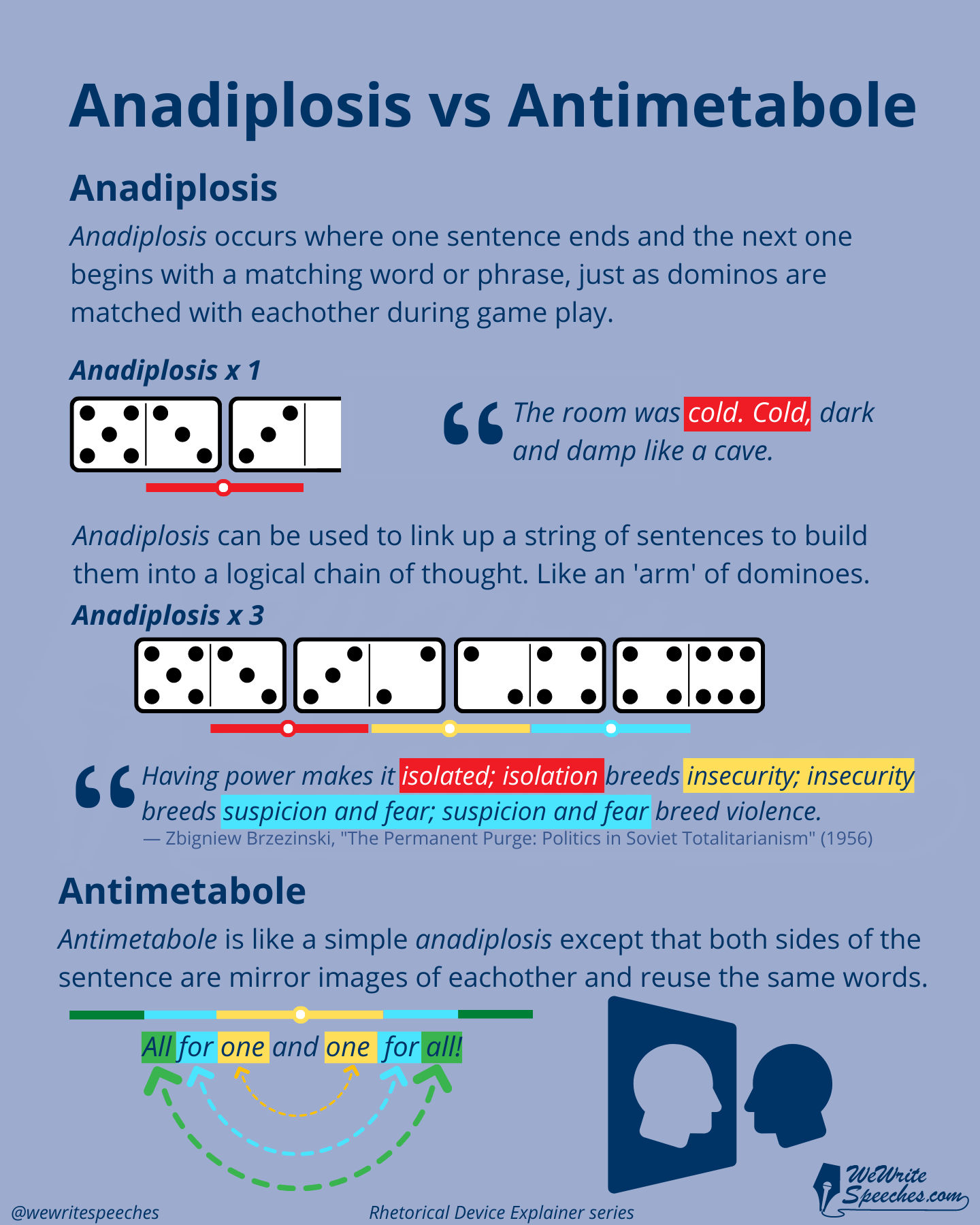Rhetorical Device: Anadiplosis
Examples
The Bible uses anadiplosis quite a lot starting from the very first lines.In the beginning God created the heaven and the earth.
And the earth was without form, and void; and darkness was upon the face of the deep.
And the Spirit of God moved upon the face of the waters. Bible, "King James Version" Genesis 1:1-2
Malcolm X used the technique in 1964 to build a logical path between philosophy and action:
Once you change your philosophy, you change your thought pattern. Once you change your thought pattern, you change your attitude. Once you change your attitude, it changes your behavior pattern and then you go on into some action. Malcolm X, "The Ballot or the Bullet" (1964)
The dimunitive Star Wars character Yoda draws a clear connection between fear and suffering using anadiplosis:
Fear leads to anger. Anger leads to hate. Hate leads to suffering. Yoda

Here is political scientist and former US President Jimmy Carter's National Security Advisor Zbigniew Brzezinski writing about totalitarian leadership:
Having power makes it isolated; isolation breeds insecurity; insecurity breeds suspicion and fear; suspicion and fear breed violence. Zbigniew Brzezinski, "The Permanent Purge: Politics in Soviet Totalitarianism" (1956)
The words or phrases repeated as part of anadiplosis do not have to be next to eachother. Take the following two examples:
Suffering breeds character; character breeds faith; in the end faith will not disappoint. Jesse Jackson, "DNC convention speech" (1988)
When I'm in England, I say, I'm from Ireland.
When I'm in Ireland, I say, I'm from Dublin.
When I'm in Dublin, I say, I'm from Crumlin.
When I'm in Crumlin, I say, Leighlin Road.
When I'm in Leighlin Road, I say, I'm a Lynott. Phil Lynott (lead singer, bassist, and songwriter with Irish rock group Thin Lizzy)
A good way to remember this technique, especially for anyone who has ever been to an Irish singalong, is to think of the Irish folk song The Rattlin' Bog. The Rattlin' (meaning 'splendid') bog is a cumulative song that has a list at the end of each verse which grows throughout the piece. Each line in that list is tied to the next using essentially the same device as anadiplosis. Here is the verse at the end of one of the longer versions of the song:
On that heel there was a nail,
A rare nail, a rattlin’ nail,
And the nail on the heel,
And the heel on the shoe,
And the shoe on the leg,
And the leg on the flea,
And the flea on the feather,
And the feather on the chick,
And the chick in the egg,
And the egg in the nest,
And the nest on the twig,
And the twig on the branch,
And the branch on the tree,
And the tree in the hole,
And the hole in the bog,
And the bog down in the valley-o. Last verse from The Rattlin' Bog (Traditional Irish song)
Anadiplosis is related to another rhetorical device called antimetabole. Whereas anadiplosis involves the ending of one sentence/phrase being repeated at the beginning of the following sentence/phrase, antimetabole involves much more of the sentence being repeated and in reverse order (like a mirror reflection).
We use metaphoric imagery in our Rhetorical Device explainer card series in order to make the devices easier to understand and more memorable. We used dominoes for anadiplosis because of how that game is played; specifically, how one can be joined to the other by matching a pattern. This imagery also neatly explains how anadiplosis can be used to link a chain of ideas together in a progression.
For antimetabole we used a different image; that of a mirror. If you take a sentence like the motto of The Three Musketeers: "All for one and one for all", it can be easily seen that the word 'one' is repeated at the end of one clause and at the beginning of the next. Yet this is more than an anadiplosis. Both sides of the sentence beyond the 'pivot' in the middle, are mirror images of eachother. All antimetabole actually contain an instance of anadiplosis, however the opposite is not true. For example the phrase "The room was cold; cold, damp and dark like a cave" is an instance of anadiplosis but not of antimetabole.

